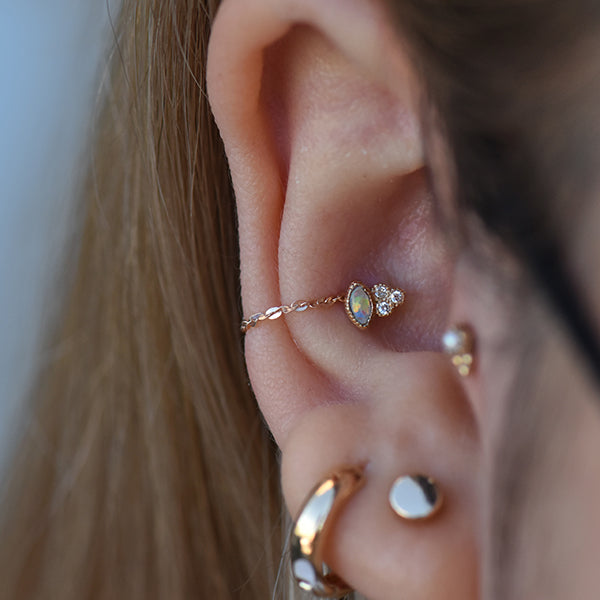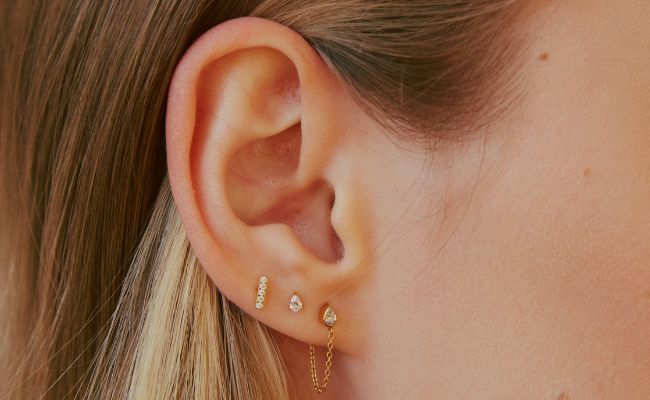Ask a Piercer:
Ryan Dreyfuss of Relic Body Arts
Ryan Dreyfuss of Relic Body Arts found connection and meaning in the piercing community as a high schooler growing up in Seattle, Washington. “My forever goal is to make people more confident in themselves, to show them their worth when they can’t see it, and to give them the same sense of a community I received when I was a teenager being bullied," says Ryan.
Read on to learn why piercings are meaningful, what you should know before getting your piercing, and how to take care of your piercing to heal in the best way possible.

Why are piercings meaningful to you?
“The piercing community during that time was a life saver. People just like me, the “weirdos”, found an outlet for whatever troubles life was throwing at them. To some, using the pain of piercing to cope with the pain of life in combination of that instant gratification of new jewelry could be seen as morbid, but it was a healthy outlet in my mind. The lesser of two evils,” says Ryan.
Ryan was instantly hooked - as he found community and connection in his new online family, he got more piercings of his own. By his junior year of high school, he took the next step and started his piercing apprenticeship. Over the next ten years, his views and motivations have evolved as he has, but the one constant is why he does what he does.
“My forever goal is to make people more confident in themselves, to show them their worth when they can’t see it, and to give them the same sense of a community I received when I was a teenager being bullied. In short, yes I pierce people for a living, but everyone gets pierced for a reason. Some people get pierced to celebrate a time in their life while others use it to cope with something. Either way I want to offer them a safe, positive space where they can be confident they will get the best service possible.”
What are you best known for? What’s your specialty?
Today I am known for what is widely known on the internet as “ear curating”. Ear curating is where a piercing specialist looks at your ear anatomy, lifestyle and personal aesthetic to suggest the best piercing placements and jewelry styles that only complement each other and you.
What trends have you been seeing for piercings or piercing combinations?
We have been doing a lot of “stacked” earlobes at our studio. Stacked earlobes are two separate earlobe piercings that are placed vertically on top of one another. Stacked ear piercings are a great way to transform your awkwardly placed “Claire's” piercing you got in grade school into a setup that now looks intentional and elegant.
What do you wish people knew before coming to get a piercing?
Most of my clients are well informed about the piercing process, but for some of my newer clients, healing times and cost seem to be talking points. I have found that some clients are seeking a new piercing but haven't done much research.
Healing times can range from as quick as six to eight weeks all the way up to a full year - so depending on your commitment and lifestyle, certain piercings may not be the best choice. So I would say always do your research on the piercing you are wanting to get and seek out a reputable piercer in your area if you have any questions prior to getting your piercing.
The next topic is cost. Jewelry quality is a crucial factor for the healing process. In this case it really is true that “you get what you pay for.” Reputable jewelry manufacturers within the industry are continuously evolving to meet the needs and desires of piercers and their clients. Quality jewelry will reflect a higher price point.
What should you bring with you to your piercing appointment? What decisions should you have made beforehand?
Every state is different on what is required for your appointment, but generally you will bring a valid government issued ID for your consent form. Some people also choose to bring what I like to call a “battle buddy”: a friend that can help you get through the normal fear of getting pierced. It is also a great idea to have eaten at least four hours before your appointment, to wear suitable clothing, and where applicable, to tie back your hair.
Before coming into your appointment, you should have decided on a general vision of what you are looking to achieve. This can be ideas about piercing placement, jewelry styles or a mood board of screenshots of completed ears that you love for inspiration. From there, your piercing specialist can lead you in the right direction based on your anatomy and lifestyle.
What should you look for when deciding on a piercer and piercing shop?
The most important thing to do when thinking about getting your next piercing is do your research. Find a reputable piercer in your area that meets, but ideally exceeds, all requirements set through your state.
At a minimum this means your piercer will have a clean, inviting studio, an in depth portfolio showing healed work, and has met all standards set forth by the Association of Professional Piercers. You can find many reputable piercers through the Association of Professional Piercers website or even send me a direct message and I will do my best to send you in the right direction.
What questions should you ask your piercer before your appointment?
After you have sought out a reputable piercer in your area that follows all local guidelines, there are some questions you may want to ask. Within the studio, you can always ask for a tour to make sure you are comfortable with the staff and environment. In my opinion this is huge! You will want to be able to easily talk to your piercing specialist and understand the ins and outs of the piercing process.
Prior to your appointment, feel free to ask your piercer anything about the piercing process. We are here to help and guide you! The most common questions are about healing time, lifestyle limitations while healing, and even if you can/should travel afterwards. No question is a bad question.



See more of Ryan's work on Instagram at @relicbodyarts


